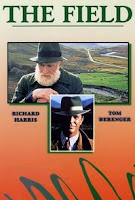I think it's set in the 1930s, though it's not easy to tell. It might be the 1950s. Electricity has just arrived in the village...there is nothing else technological, and no reference to outside events, that might help to place the exact time. But the Famine is still a living memory and source of pain. There's a really strange ambivalent attitude to those who emigrated and left their land...are they traitors or victims? Similarly the tinkers who are in the village are regarded as having lost 'caste' because they are the descendants of people who abandoned their land.
I was slightly put off at the beginning by the murkiness of the colours, but I came to realise that anything else would have been wrong. It's a dark film and needs to be dark visually. This is like a Greek tragedy, but with protagonists who are poor.
We watched this at a community arts centre in Kenmare, a tiny town in the west of Ireland, where villages like the one depicted are all around, at a free showing by a community group that provided meals on wheels to the poor and isolated. There was free tea and cake too...we made a donation that was not expected and received with much thanks.


No comments:
Post a Comment